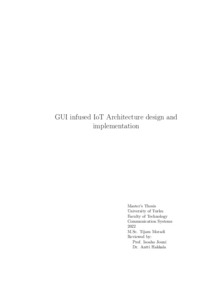GUI infused IoT Architecture design and implementation
Moradi, Tijam (2022-02-16)
GUI infused IoT Architecture design and implementation
Moradi, Tijam
(16.02.2022)
Julkaisu on tekijänoikeussäännösten alainen. Teosta voi lukea ja tulostaa henkilökohtaista käyttöä varten. Käyttö kaupallisiin tarkoituksiin on kielletty.
avoin
Julkaisun pysyvä osoite on:
https://urn.fi/URN:NBN:fi-fe2022022220330
https://urn.fi/URN:NBN:fi-fe2022022220330
Tiivistelmä
In this thesis a system architecture that can facilitate graphical user interfaces (GUIs) in in IoT framework is designed. The desired result is the above with remote management, remote controllability, flexibility and extendability. The thesis aims to answer whether building a system like this is possible, feasible, efficient and relatively easy to achieve, and also takes and approaches the productisation of the system via a case study.
Thesis case provides purpose and an area of research. The case involves building a tailorable apartment staircase digital signage, which has remote administration and controllability options. This case is a startup by nature, and the whole product is designed by the writer. Thesis case targets apartment environments. Real life issues, such as notification board management, has inspired this project.
Thesis research has a heavy influence of empiric methods in comparison to theoretical ones. Since the case solves a very practical problem and the scope is the development and productisation phase, there were not many traditional measuring methods. However, positive results were established by the conclusion of the thesis. Feasibility and sustainability of the system were the main measures, which compared the architecture design to execution results.
Upon these positive results, the thesis concludes that the described system is feasible and sustainable to build. However, alternate methods might have been more successful. The conclusion furthermore suggests that the case is achievable and fruitful with the methods used.
Thesis case provides purpose and an area of research. The case involves building a tailorable apartment staircase digital signage, which has remote administration and controllability options. This case is a startup by nature, and the whole product is designed by the writer. Thesis case targets apartment environments. Real life issues, such as notification board management, has inspired this project.
Thesis research has a heavy influence of empiric methods in comparison to theoretical ones. Since the case solves a very practical problem and the scope is the development and productisation phase, there were not many traditional measuring methods. However, positive results were established by the conclusion of the thesis. Feasibility and sustainability of the system were the main measures, which compared the architecture design to execution results.
Upon these positive results, the thesis concludes that the described system is feasible and sustainable to build. However, alternate methods might have been more successful. The conclusion furthermore suggests that the case is achievable and fruitful with the methods used.
